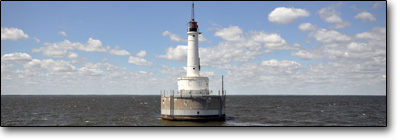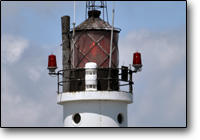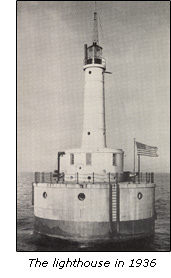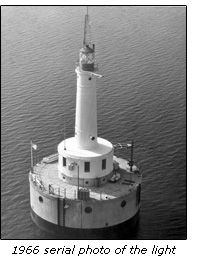 |
 |
|
| Click thumbnails to view enlarged images | ||
| Green Bay Harbor Entrance Light | Seeing The Light |
|
|
|
| Historical Information The
shipping channel approaching the Fox River in Green Bay changed a
number of times over the years in order to accommodate vessels of
increasing draft, and with the Army Corps of Engineers again modifying
the channel in the mid 1920’s, it was necessary to mark a turning point
in the channel as it bent from the man approach to the dredged channel
through Grassy Island and the river mouth beyond. To mark this point
until funds could be arranged for a more permanent Solution, the Bureau
of Lighthouses established the Green Bay Harbor Entrance buoy in 1927.
Consisting of an acetylene buoy and wave activated bell, the buoy
emitted a flash of 0.3 seconds duration every 3 seconds.  Federal
funds for more substantial structures at the Harbor Entrance and to
replace the aging Peshtigo Reef light ship were finally allocated in
1934 and work began immediately on drawing-up plans and specifications
for the pair of virtually identical structures. Federal
funds for more substantial structures at the Harbor Entrance and to
replace the aging Peshtigo Reef light ship were finally allocated in
1934 and work began immediately on drawing-up plans and specifications
for the pair of virtually identical structures. Construction on the Green Bay Harbor Entrance Light began in the spring of 1935 with the fabrication of a fifty foot diameter caisson on shore in Green Bay. Fabricated of steel sheets covering internal timber support frames, the structure was towed out to the selected location on June 5, 1935 and sunk in place through the addition of crushed stone into the center of the caisson. Following standard crib light construction, wooden forms were then erected atop the caisson and the base pier cast of concrete within these forms. While casting this pier, a large circular room was cast within, with circular openings into which maritime portholes were fitted to provide light into the center of the pier. Because the lighthouse was powered by a submarine cable from shore, the equipment room served as home to electrically powered air compressors for the station’s diaphragm horn and a backup generator.  Atop
this pier, the lighthouse itself was designed in cylindrical form,
containing living quarters for the tow man crew who would man the
station. Centered atop this main structure, a cylindrical tower was
erected and capped with a lantern with helical astragals to ensure
uninterrupted horizontal light emission. Outfitted with an
electrically-powered Fourth Order Fresnel optic, the light stood 72
feet above the water, emitted 6,000 candlepower and was visible for a
distance of 16 miles in clear weather conditions. Atop
this pier, the lighthouse itself was designed in cylindrical form,
containing living quarters for the tow man crew who would man the
station. Centered atop this main structure, a cylindrical tower was
erected and capped with a lantern with helical astragals to ensure
uninterrupted horizontal light emission. Outfitted with an
electrically-powered Fourth Order Fresnel optic, the light stood 72
feet above the water, emitted 6,000 candlepower and was visible for a
distance of 16 miles in clear weather conditions.Work on the station was completed with the installation of a radiobeacon antenna atop the lantern, which emitted the station characteristic “dash dot dash” signature at a frequency of 314 kilocycles. The light was automated in 1979, and is one of the few on the Great Lakes still to be powered by submarine cable. While the light is now issued from a pair of 300mm Tideland Signal ML300 acrylic optics mounted on the gallery railing, the Fresnel lens can still be seen within the lantern, and will doubtless be removed in the near future.
Keepers of this
Light Seeing this Light GPS Coordinates: 44°39'10.35"N x 87°54'4.02"W Reference Sources Oshkosh Daily News, November 12 1935 Annual reports of the Lake Carriers Association, 1936 Reports of the Department of Commerce, varios Appleton Post Crescent, January 21, 1959 Youngstown Vindicator, December 14, 1977 |